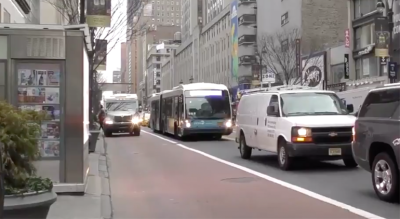Service Is Slipping On Key SBS Routes, New Data Show


The MTA’s Select Bus Service are running slower overall than last year, and are dropping on several key lines, even as the de Blasio administration vowed to improve bus speeds by 25 percent by the end of 2020.
Average SBS speeds have dropped from 9.1 miles per hour in October, 2018, to 8.8 miles per hour this October (the most recent available monthly data), a 3.2-percent decline. In addition, bus speeds have fallen on five individual lines in the same time period:
- BX12 SBS (between Inwood and Co-op City): 9.2 miles per hour in October 2018 to 8.9 miles per hour in October 2019 (a 3.2-percent decline)
- M34A SBS (between Waterside Plaza and the Port Authority Bus Terminal): 4.8 miles per hour to 4.6 miles per hour (4.1 percent)
- Q44 SBS (between Jamaica, Queens and West Farms, the Bronx): 9.8 miles per hour to 9.5 miles per hour (3 percent)
- Q52 SBS (between Woodside and Arverne): 14.4 miles per hour to 14.0 miles per hour (2.7 percent)
- Q70 SBS (between Woodside and LaGuardia Airport): 13 miles per hour to 12.4 miles per hour (4.6 percent)
Bus speeds stayed flat on the B82 SBS (8.3 miles per hour over the year) and the M34 (5 miles per hour).

The new data comes as activists will be calling for upgrades to the Q44, among other lines, at a rally at City Hall on Wednesday afternoon focused on making sure Mayor de Blasio delivers on his promise to speed buses by 25 percent by the end of 2020 through the use of bus lanes, busways and upgraded bus stops.
Select Bus Service, the city’s version of bus rapid transit, is distinguished from local bus service by the service’s use of off-board payment and all-door boarding, fewer stops than local buses and routes that run on camera-enforced bus lanes with transit signal priority. There are currently 17 SBS routes in the city, with at least one in each borough, and the lines serve over 300,000 riders per day.
Department of Transportation Commissioner Polly Trottenberg praised the increased ridership and bus speeds that Select Bus Service generally provides. But Trottenberg also said that on some lines “we’re starting to see those results erode and what we’re going to be doing in the coming years is going back to them, refining them, retooling them.”
Trottenberg did not specify which routes would get what refinements or what could be leading to the erosion, as she called it at a Monday transit event. But congestion likely plays a role; car ownership in the city has risen by 9 percent compared to just a 3.2 percent population rise since 2010, and the number of taxi and for-hire-vehicle rides taken in the city has gone up 90 percent since 2010 as well according to the DOT Mobility Report. But it could also be that once an SBS route is carved out, it can be difficult to perpetually improve service.
MTA spokesman Tim Minton told Streetsblog that the slowdowns on the BX12, Q44 and Q52 were due to ongoing construction by the city’s Department of Design and Construction, including a bus bulb construction along the Q44 route, and predicted that as the work finished along each route, that speeds would tick up.
In addition, the M14 SBS — introduced in July — contributes to the lower overall SBS average speed, since the crosstown M14A and M14D SBS buses move at roughly 5.5 miles per hour — still much faster than the non-SBS buses before the car-free busway was instituted. The busway, Minton said, is “the future of the bus in New York City.”
Since January, 2015, the system-wide average bus speeds on SBS routes has hovered around 9 miles per hour, but October’s 8.8 mile per hour average speed is among the system’s lowest average speeds.
Any decline in speeds shows that buses have to not only be given priority on city streets but that priority must be maintained effectively to avoid service declines, said Danny Pearlstein of the Riders Alliance.
“In crucial areas of every neighborhood where commercial streets are congested and bus riders are going there, buses should be faster than other ways of getting around so people have incentives to use the bus,” Pearlstein said. “It’s overwhelmingly clear that what bus riders need is priority on city streets.”
And ahead of Wednesday’s rally, Pearlstein also challenged the city and the MTA to think bigger than just maintaining existing SBS speed and service capacity on some routes, and to install full-time Busways for the city’s busiest bus lines, such as the BX12, which goes across the Bronx on Fordham Road.
The BX12 and M34A are familiar names in Busway discourse. Bronx activists have called for the installation of a bus-only route on traffic-choked Fordham Road to stop the hemorrhage of riders with improved service.
In October, Corey Johnson suggested that 34th Street, where buses crawl along under five miles per hour and the dream of a Busway lived and died between 2008 and 2011, could be ripe for a Busway as well.
In lieu of banning cars from certain routes, Ben Fried of the TransitCenter said that the MTA should be working overtime to get their much-ballyhooed in-bus enforcement cameras rolled out on SBS routes — not just the current three.
“It’s up to the MTA to accelerate the rollout of bus-mounted cameras,” Fried said, pointing out that the agency has the all-clear from the state legislature to move as fast as it wants on the camera installations. So far the cameras are handing out warnings to bus lane blockers in front of the M14SBS, and are giving out actual tickets to scofflaws in front of the B44SBS and the M15SBS.
